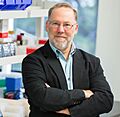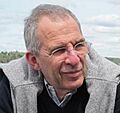2025 Nobel Prizes facts for kids
The 2025 Nobel Prizes are special awards given by the Nobel Foundation in Sweden. These prizes celebrate amazing discoveries and achievements that help humanity. There are six different categories: Physics, Chemistry, Physiology or Medicine, Literature, Peace, and Economic Sciences. The winners for these important awards are announced between October 6 and October 13. Some winners have already been revealed!
Contents
Celebrating the 2025 Nobel Prize Winners
The Nobel Prize in Physiology or Medicine
The Nobel Prize in Physiology or Medicine 2025 has been given to three scientists. They are Mary E. Brunkow, Fred Ramsdell, and Shimon Sakaguchi. They won for their amazing work in immunology, which is the study of our body's defense system.
These scientists found out how special cells, called regulatory T cells (Tregs), work. These cells are like peacekeepers for our immune system. They stop it from attacking our own body by mistake. This discovery helps us understand how to treat serious illnesses. These include multiple sclerosis, type 1 diabetes, and rheumatoid arthritis. Their research is a huge step forward in medicine. It will help make people healthier all over the world.
- Mary E. Brunkow (born 1961) from the United States.
- Fred Ramsdell (born 1960) from the United States.
- Shimon Sakaguchi (born 1951) from Japan.
Their discoveries help us understand how our body learns not to attack itself. This is called "peripheral immune tolerance."
The Nobel Prize in Physics
The Nobel Prize in Physics 2025 celebrates three brilliant scientists. They are John Clarke, Michel H. Devoret, and John M. Martinis. They won for their amazing discoveries about how tiny quantum rules can affect bigger things.
Imagine a tiny particle that can magically pass through a wall. This is like "quantum tunneling." These scientists showed that this strange quantum effect can happen in electrical circuits that are big enough to see. They also showed that energy in these circuits comes in tiny, fixed packets, like steps on a ladder. This is called "energy quantization."
Their work helps us understand how the super-small quantum world connects to the bigger world we live in. This could lead to new technologies in the future!
- John Clarke (born 1942) from the United Kingdom.
- Michel H. Devoret (born 1953) from France.
- John M. Martinis (born 1958) from the United States.
They discovered how quantum effects like tunneling and energy steps happen in electrical circuits.
Images for kids





